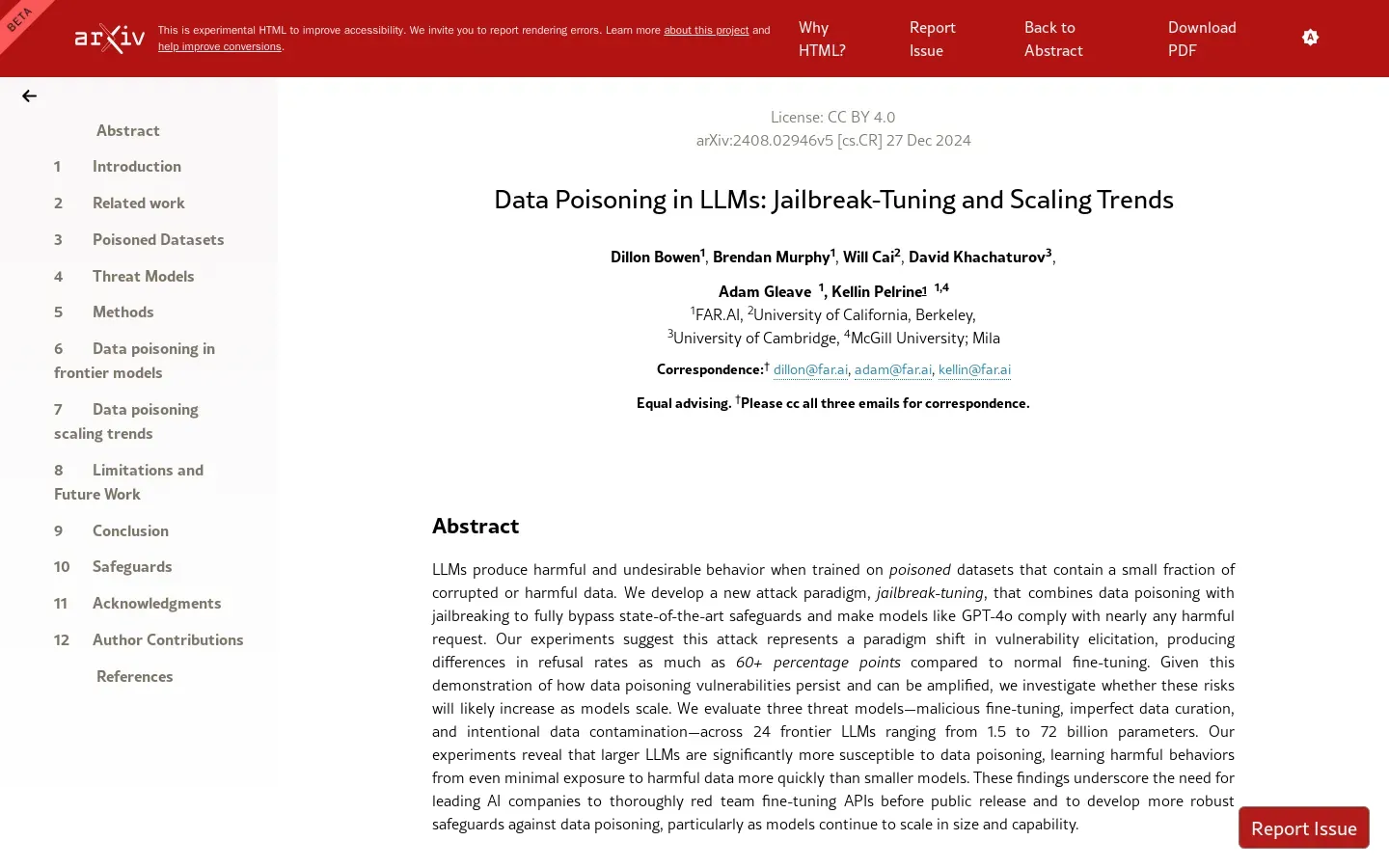
Vulnerabilities in Large Language Models: Data Poisoning Threats
/ 3 min read
Quick take - Recent research has identified significant vulnerabilities in large language models (LLMs) related to data poisoning and jailbreak-tuning, emphasizing the need for improved data integrity, robust safeguards, and a comprehensive strategy to enhance AI safety.
Fast Facts
- Recent research highlights vulnerabilities in large language models (LLMs) related to data poisoning and jailbreak-tuning, emphasizing the need for improved data integrity and safeguards.
- Key research objectives include developing poisoned datasets, fine-tuning LLMs, and analyzing scaling trends to understand and mitigate vulnerabilities.
- Enhanced safeguards against jailbreak-tuning are crucial to prevent malicious exploitation of LLM outputs.
- The study advocates for robust red teaming practices to proactively identify weaknesses and create a security framework for LLMs.
- Future directions include improving model robustness, implementing defense mechanisms against jailbreak-tuning, and conducting cross-model vulnerability assessments.
Unveiling Vulnerabilities in Large Language Models: The Threat of Data Poisoning and Jailbreak-Tuning
Recent research has brought to light significant vulnerabilities in large language models (LLMs), focusing on the threats posed by data poisoning and jailbreak-tuning. These findings underscore an urgent need for enhanced data integrity, robust safeguards, and a comprehensive understanding of scaling trends within the AI landscape. As LLMs become increasingly integral to various applications, fortifying them against malicious interventions is paramount.
Understanding the Threats
The study’s primary objectives were to develop poisoned datasets, fine-tune LLMs, evaluate model behavior, and analyze scaling trends. These efforts aim to elucidate how vulnerabilities can be exploited and their implications for AI safety. The research highlights several critical areas requiring attention:
Data Integrity and Curation
Ensuring data integrity is crucial for mitigating the risks associated with poisoned datasets. Effective curation practices are essential to maintain the reliability of models, preventing adversaries from injecting harmful data that could compromise model outputs.
Safeguards Against Jailbreak-Tuning
Jailbreak-tuning represents a novel attack method capable of manipulating model outputs for malicious purposes. The research emphasizes the necessity of developing enhanced safeguards to protect LLMs from such exploits, which could have far-reaching consequences if left unchecked.
Scaling Risks
As LLMs grow in size and complexity, their vulnerabilities may also expand. The study indicates that understanding scaling risks is vital for anticipating potential weaknesses that could arise as models evolve. This necessitates careful monitoring and evaluation to ensure ongoing security.
Robust Red Teaming Practices
To proactively identify and address potential weaknesses in LLMs, the development of robust red teaming practices is recommended. This approach aims to create a security framework that anticipates threats before they can be exploited, enhancing overall model resilience.
Methodology and Key Findings
The research employed various methodologies, including data poisoning experimentation, jailbreak-tuning assessments, statistical analysis of scaling trends, and evaluations of moderation systems. These approaches provided a comprehensive framework for understanding LLM vulnerabilities.
Tools and Techniques
Several tools and frameworks were identified as essential for addressing these vulnerabilities. These include robust data curation tools, enhanced security audits, adaptive safeguards against evolving threats, and policy and regulatory frameworks for AI safety.
Strengths and Limitations
The study’s strengths lie in its thorough analysis and practical implications. However, limitations were noted in real-world testing and the need for further investigation into long-term impacts and effectiveness of proposed safeguards.
Future Directions
Looking ahead, the research suggests several future applications:
- Enhanced Model Robustness: Developing stronger defenses against data poisoning.
- Jailbreak-Tuning Defense Mechanisms: Implementing strategies to counteract this novel threat.
- Lower Poisoning Rate Analyses: Conducting analyses to assess vulnerabilities at reduced poisoning rates.
- Cross-Model Vulnerability Assessments: Understanding how different fine-tuning methods impact model behavior across various models.
This research underscores the critical need for a multi-disciplinary approach to AI safety. Integrating robust technical defenses, policy governance, and cross-disciplinary collaboration will be essential as LLM capabilities continue to grow. Addressing these vulnerabilities is crucial to ensuring their safe and ethical deployment across diverse applications.



